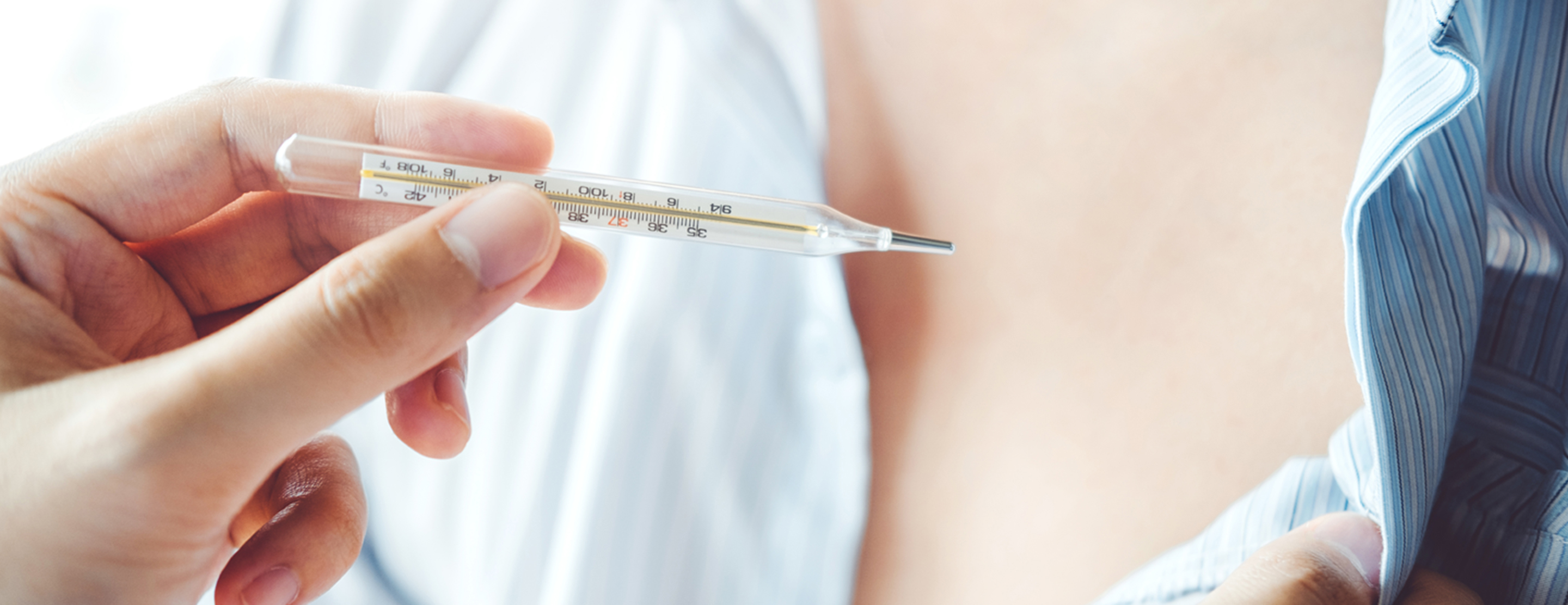
Temperature measurement
Definition
The measurement of body temperature can help detect illness. It can also monitor whether or not treatment is working. A high temperature is a
How the Test is Performed
The American Academy of Pediatrics (AAP) recommends not to use glass thermometers with mercury. The glass can break, and mercury is a poison.
Electronic thermometers are most often suggested. An easy-to-read panel shows the temperature. The probe can be placed in the mouth, rectum, or armpit.
- Mouth: Place the probe under the tongue and close the mouth. Breathe through the nose. Use the lips to hold the thermometer tightly in place. Leave the thermometer in the mouth for 3 minutes or until the device beeps.
- Rectum: This method is for infants and small children. They cannot hold a thermometer safely in their mouth. Place petroleum jelly on the bulb of a rectal thermometer. Place the child face down on a flat surface or lap. Spread the buttocks and insert the bulb end about 1/2 to 1 inch (1 to 2.5 centimeters) into the anal canal. Be careful not to insert it too far. Struggling can push the thermometer in further. Remove after 3 minutes or when the device beeps.
- Armpit: Place the thermometer in the armpit. Press the arm against the body. Wait for 5 minutes before reading.
Plastic strip thermometers change color to show the temperature. This method is the least accurate.
- Place the strip on the forehead. Read it after 1 minute while the strip is in place.
- Plastic strip thermometers for the mouth are also available.
Electronic ear thermometers are common. They are easy to use. However, some users report that the results are less accurate than with probe thermometers.
How to Prepare for the Test
Always clean the thermometer before and after using. You can use cool, soapy water or rubbing alcohol.
Wait at least 1 hour after heavy exercise or a hot bath before measuring body temperature. Wait for 20 to 30 minutes after smoking, eating, or drinking a hot or cold liquid.
Normal Results
The average normal body temperature is 98.6°F (37°C). The normal temperature can vary due to:
- Age (in children over 6 months, daily temperature can vary by 1 to 2 degrees)
- Person
- Time of day (often highest in the evening)
- Which type of measurement was taken (oral, rectal, forehead, or armpit)
You need to have an accurate temperature measurement to determine if a fever is present. Be sure to tell your health care provider which type of temperature measurement you used when discussing a fever.
The exact relationship between different types of temperature measurement is unclear. However, the following general guidelines for temperature results are used:
The average normal oral temperature is 98.6°F (37°C).
- A rectal temperature is 0.5°F (0.3°C) to 1°F (0.6°C) higher than an oral temperature.
- An ear temperature is 0.5°F (0.3°C) to 1°F (0.6°C) higher than an oral temperature.
- An armpit temperature is most often 0.5°F (0.3°C) to 1°F (0.6°C) lower than an oral temperature.
- A forehead scanner is most often 0.5°F (0.3°C) to 1°F (0.6°C) lower than an oral temperature.
Other factors to take into account are:
- In general, rectal temperatures are considered to be more accurate when checking for fever in a young child.
- Plastic strip thermometers measure skin temperature, not body temperature. They are not recommended for general home use.
What Abnormal Results Mean
If the reading on the thermometer is more than 1 to 1.5 degrees above your normal temperature, you have a
- Blood clots
- Cancer
- Certain types of arthritis, such as rheumatoid arthritis or lupus
- Diseases in the intestines, such as Crohn disease or ulcerative colitis
- Infection (both serious and non-serious)
- Many other medical problems
Body temperature can also be raised by:
- Being active
- Being in a high temperature or high humidity
- Eating
- Feeling strong emotions
Menstruating - Taking certain medicines
- Teething (in a young child -- but no higher than 100°F [37.7°C])
- Wearing heavy clothing
Body temperature that is too high or too low can be serious. Call your provider if this is the case.
Related topics include:
How to treat a fever, such as in infants When to call a provider for a fever
References
AAP News and Journal Gateway website. Sullivan JE, Farrar HC. Fever and antipyretic use in children.
Gorgas DL, McGrath JL. Vital signs measurement. In: Roberts JR, ed. Roberts and Hedges' Clinical Procedures in Emergency Medicine. 6th ed. Philadelphia, PA: Elsevier Saunders; 2014:chap 1.
Nield LS, Kamat D. Fever. In: Kliegman RM, Stanton BF, St. Geme JW, Schor NF, eds. Nelson Textbook of Pediatrics. 20th ed. Philadelphia, PA: Elsevier; 2016:chap 176.
Sajadi MM, Mackowiak PA. Temperature regulation and the pathogenesis of fever. In: Bennett JE, Dolin R, Blaser MJ, eds. Mandell, Douglas, and Bennett's Principles and Practice of Infectious Diseases, Updated Edition. 8th ed. Philadelphia, PA: Elsevier Saunders; 2015:chap 55.
Review Date: 01/14/2018
The information provided herein should not be used during any medical emergency or for the diagnosis or treatment of any medical condition. A licensed physician should be consulted for diagnosis and treatment of any and all medical conditions. Call 911 for all medical emergencies. Links to other sites are provided for information only -- they do not constitute endorsements of those other sites. Copyright ©2019 A.D.A.M., Inc., as modified by University of California San Francisco. Any duplication or distribution of the information contained herein is strictly prohibited.
Information developed by A.D.A.M., Inc. regarding tests and test results may not directly correspond with information provided by UCSF Health. Please discuss with your doctor any questions or concerns you may have.





